
The Basics:
- For ages 9 and up (publisher suggests 10+)
- For 2 players
- Approximately 30 minutes to complete
Geek Skills:
- Counting & Math
- Logical & Critical Decision Making
- Reading
- Memory & Pattern/Color Matching
- Strategy & Tactics
- Hand/Resource Management
- Area Control
Learning Curve:
- Child – Easy
- Adult – Easy
Theme & Narrative:
- Meet with the village elders and persuade them to side with your army
Endorsements:
- Gamer Geek approved!
- Parent Geek approved!
- Child Geek approved!
Overview
It’s a time of war, famine, and death. You have fought hard, but to no avail. Victory remains elusive, but there is hope. If you could win the favor of the village elders who control key routes along a river used for trade, you could control the flow of goods and resources used by your foes. Turning your army to the north, you make haste to the river. Your spies have informed you that your enemy plans the same tactics and only one can win.
Four Tribes, designed by Jason Glover and published by Grey Gnome Games, is comprised of 72 Army cards (36 green, 36 orange), 6 Village cards (double-sided), 3 Long House cards (double-sided), 50 Village Houses (12 each in colors red, yellow, blue, and green; plus 2 black), 12 Village Elders (3 each in the colors red, yellow, blue, and green), and 1 small bag. The artwork on the cards is well done and the component quality is excellent.
Game Set Up
To set up the game, first take all the Village Houses and place them in the small bag. Mix the contents of the small bag and place it to one side of the game playing area for now.
Second, shuffle the 6 Village cards and then place them in a row between the two players. When placing the Village cards, ensure the river that divides the Village cards are connected.
Third, give each player 1 Long House card and place the third unclaimed Long House card next to the Village card row. Leave room next to the third Long House card for a discard pile for each player and for previously played Village Houses.
Fourth, hand to each player 1 deck of cards (1 player will get the green Army deck, 1 player the orange Army deck). Have each player shuffle their deck, place it face-down to the side, and draw the first 6 cards. This is the player’s hand. The remaining cards are the player’s draw pile for the duration of the game. Players should keep their cards hidden from their opponents at all times until played.
Fifth, place 1 Village Elder on each of the Village cards on the spot that matches the Village Elder color. The remaining 6 Village Elders should be placed in the Long House card next to the Village card row.
Sixth, randomly draw 1 Village House from the small bag for every square area found on each of the Village cards. Place the small bag to the side of the game playing area when done. Each Village card should now have 1 Village Elder and a mix of Village Houses. When completed, your playing area might look similar to the following image.
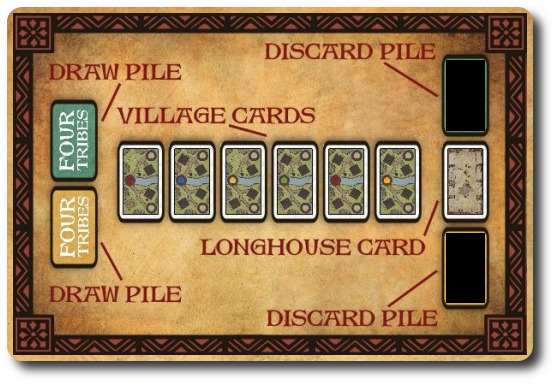
The game is now ready to play! Decide who will go first and begin!
The Not So Subtle Art of Influencing Others
Four Tribes is played during a time of war in which both players are attempting to not only continue to battle each other, but also persuade the local Village Elders to join with them. The game itself is played in turns with no set number of turns per game. On a player’s turn, they will complete two sequential steps.
Step 1: Play a Card
From their hand of cards, the player will now select 1 card to play to 1 Village card. Each Village card has a number of Village Houses and 1 Village Elder. The number of Village Houses determines the number and color of Army cards that can be played to each Village card. The Village Elder represents the local leader the players are attempting to influence. Influence is only obtained through bribes to the village and a show of force against the player’s opponent.
Each Army deck contains the same number and type of cards. They are summarized here:
“Provision” Army Cards
The player can attempt to influence and obtain favor by providing the local village much-needed provisions during a time when war and famine have robbed the land of many of its natural resources. Or, the player could show the Village Elder their martial power and attack their opponent on the other side of the river. Each “Provision” card has a number (1 through 7) and a color (red, yellow, blue, and green). The majority of “Provision” Army cards must be played on the player’s side of the river.
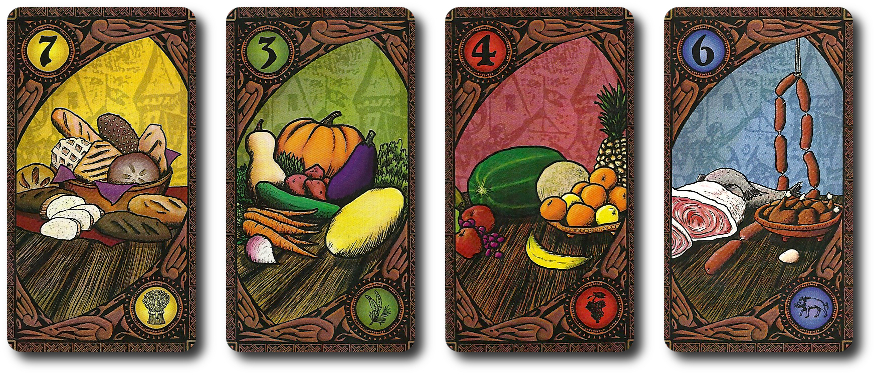
The one exception is the Dragon. The Dragon “Provision” Army Card is an attack card that can be played on either side of the river. The Dragon doesn’t actually “attack”, however, but it does greatly reduce a player’s opponent’s chances of winning the favor of the contested village.

“Offering” Army Cards
The “Offering” Army card does not have any color value. It’s black, which means it can represent any color. The “Offering” can be placed on either side of the river, allowing a player to play to their opponent’s side of a contested village.
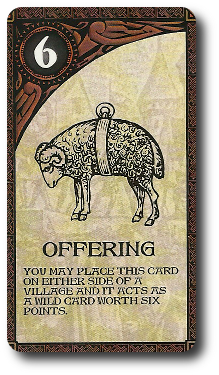
“Guardian” Army Cards
The “Guardian” Army card does not have any color value, meaning it’s also wild. The “Guardian” can be played only on the player’s side of the river, and can be used (once it’s played to a Village card) to remove 1 card from the Village card it was played on or from the neighboring Village cards directly to its left and right. Only cards on the player’s side can be removed.
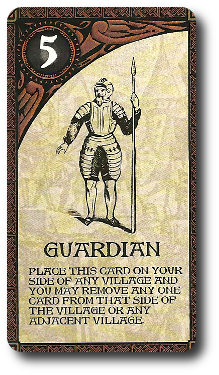
“Sanctuary” Army Cards
The “Sanctuary” Army card is also a wild card and can only be played to the player’s side of the river. When played to a Village card, the player’s opponent can no longer play any cards to the player’s side of the river for this specific Village card.
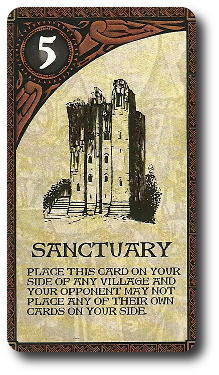
“Catapult” Army Cards
The “Catapult” Army card is wild, but can be placed on either side of the river. This is a true attack card, as it allows the player to remove 1 card on the same Village card that is on the opposite side of the river. For example, if the player places the “Catapult” Army card on their opponent’s side of the river, they can then remove the Dragon “Provision” Army card on their side of the river that is placed on the same Village card.

When playing cards to a Village card, a few rules (other than those included with the above cards) must be followed.
- The total number of cards that can be played on the player’s side of the river is determined by the number of Village Houses. For example, if the Village card had 3 Village Houses, the players can play no more than 3 cards to the Village card on their side of the river.
- The colors of the Village Houses determine what card colors that can be played to the Village card. For example, if there were 2 “Red” Village Houses and 1 “Blue” Village House, the players could not play anymore than 3 cards on their side of the river. The cards played have to be 2 red and 1 blue. Note that a “Black” Village House is considered wild and can represent any color. Players do not need to play black (wild) cards to it!
A player will play just 1 card to any Village card on their turn, face-up. A player is not required to continue to work and focus on one Village card at a time. Unless they want to, that is…
Step 2: Draw a Card
The last action the player takes on their turn is drawing a new card from their draw pile to bring their hand back up to 6 cards.
Winning Villages
A Village card remains contested until both players have played the correct number of cards and colors on both sides of the river. Again, the Village Houses determine the total number and colors of the cards that must be played. Players can never play more cards than the total number of Village Houses and cannot play colors that are not represented.
The players, once the correct number and color of cards have been played to both sides of the river, now add the number values of their played cards. The player with the highest total wins the trust of the Village Elder and takes the Village Elder from the Village card, placing it on their Long House card. The Village Houses are removed from the Village card and placed in a discard pile off to one side of the game playing area. These Village Houses are out for the duration of the game and should not be returned to the small bag. The played cards are now collected and placed, face-down, in discard piles according to their card backing color. Finally, the Village Card is flipped over and a new Village Elder is taken from the Long House by the Village card row, with random Village Houses being added to it from the small bag. This Village card can now be contested over.
If there isn’t a Village Elder available that matches the flipped Village card, it should be flipped back over. If there still isn’t a Village Elder available that matches the Village card color, the Village card is removed from play.
Winning the Game
The game continues until 1 player has either collected 1 Village Elder in each color (4 in total) or has collected 3 Village Elders of the same color.
Game Variant
The game play summarized above is considered the “standard game” for Four Tribes. There is also an “advanced game” that removes the random draw of Village Houses. Instead, the Village Houses are divided up evenly and the players take turns adding them to Village cards based on the cards they have in their hand. Once a Village has been claimed, by one player, the Village Elder is moved to a new position on the Village card that is closer to the player. This represents that the Village Elder is favoring that player, but has not yet made up their mind to fully support them. If the player is able to claim the village again, the Village Elder backs them. Village Houses are never removed from play, but are continually redistributed among the Village cards. This game variant requires much more thought by the players, strategy, and tactics. As a result, the game play length is also increased.
To learn more about Four Tribes, visit the game’s web page.
Prediction
Four Tribes combines several different game types into one. Specifically, Four Tribes has elements of Memory games and Deduction games. Players must attempt to deduce what cards their opponent has available to them and remember what cards have already been played. Using this information, the player can be competitive as they manage their own hand and attempt to remember what they have already played, as well. If this sounds difficult, it certain is, but because the cards in play are visible, a great deal of pressure is taken off the players. An individual knows exactly what their opponent is working on and their current total value of cards played to any one specific village. This is great info, as it allows the player to make choices on their turn. However, a savvy and more experienced player will quickly understand that the information visible is only partially important. Knowing what was played will help a player deduce what could be played in the near future.
This immediately feels and sounds like a game of great depth, but light game play. A great combination that often times highly appeals to both Parent and Gamer Geeks. The level of complexity and focus necessary to win the game might, however, cause the Child Geeks to give Four Tribes a mixed or rejected approval rating. It will all depend on the amount of information that is available and how useful it is to the Child Geek when they play their cards. If they think there is enough there to help them make choices, the game should do well. If the Child Geeks feel overwhelmed or confused, the game will fail.
Teaching Four Tribes is best done if the player who is the most familiar with the game sits to the side and lets the new players play against each other. Players should understand the game in its entirety after only a few turns, but do spend a few minutes going over the cards. Players need to know how to read to play a number of the cards and recognize numbers. If the player does not, they will need a partner. Never discourage or exclude a younger player from trying new games! Do partner with them for a team victory!
After teaching Four Tribes to my 2 oldest little geeks, I asked them their thoughts on the game so far.
“I like how you have to compete for the villages and play dragons!” ~ Liam (age 9)
“I’m sad I can’t play with the entire family, but it looks like a fun game.” ~ Nyhus (age 6)
My 6-year-old makes a good point. Four Tribes is a 2-player game only. Not a bad thing, mind you, as there are not a lot of 2-player only designed games. Lots of games can be played by 2-players, but games specifically designed for only 2-players tend to be much better balanced. Let’s play the game and see if Four Tribes wins our love or we kick it into the river.
Final Word
The younger Child Geeks never really got to a point where they enjoyed the game. The older ones, on the other hand, most certainly did. The recommended age for this game is pretty accurate, with my 9-year-old being a special case due to his greater than average game playing experience. Child Geeks as young as 6-years-old could play the game (with help), but the sweet spot appears to be in the age range of 10 and older. All the older Child Geeks who fell into this age ranged very much enjoyed the game and often times won games against their Parent Geeks. Four Tribes is very well-balanced and the game play is smooth. All the Child Geeks recognized the need for paying attention to the cards previously played, but had a hard time keeping it all straight in their head. The players with better memory did only slightly better than their peers who did not. Victory almost always went to the more cautions player who took their time influencing villages and only played aggressively towards a village when it was clear they would obtain it. According to one Child Geek, “What I like about this game is how much control I have over it. I’m not forced to play a card if I don’t want to, but I need to be smart about what cards I play.” All the Child Geeks, who fell into the suggested age range, voted to approve Four Tribes.
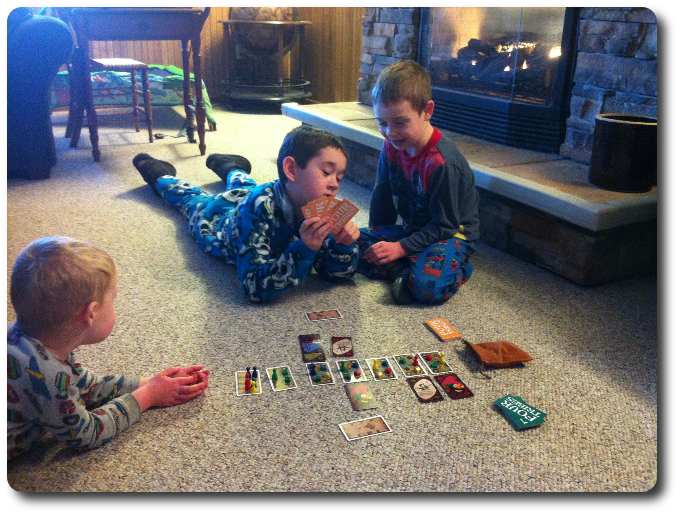
My two oldest little geeks devise a strategy while my youngest and I thwart them!
The Parent Geeks also enjoyed the game, finding it to be fun and engaging with both their family and their peers. According to one Parent Geek, “I wouldn’t approve this game if it weren’t for the fact that my kids can play it so well!” Indeed, the Parent Geeks had to work for their victories, and if their Child Geeks served as excellent opponents, their peers were all the more difficult. I observed smart game play, excellent deduction, and impressive card counting memory from the majority of the Parent Geeks. Even the non-gamer Parent Geeks did well and enjoyed themselves. The biggest disappointment the Parent Geeks had was that the game could not site more than 2 players. According to one Parent Geek, “I don’t know why you would want to only make a game for 2 players, but this game is a lot of fun. Too bad I can’t sit up to 4 players, as I’m sure it would be a lot of fun with a group.” All the Parent Geeks agreed that Four Tribes, despite only being for 2 players, was a good game and worth their approval.
The Gamer Geeks understood Four Tribes right from the start and immediately explored its depths with reckless abandon.. They very much enjoyed the casual (but necessary) hand management and the memory aspects of the game. The deduction aspect of the game was somewhat put to the side as there was still randomness to be found that somewhat trumped the value of spending time attempting to “guess” what would randomly be pulled. We tried the advanced game play with the gamer elitists and this greatly improved the need for deduction. According to one Gamer Geek, “Both game types are fun, but I prefer the advanced game play only because luck is reduced.” Another Gamer Geek said, “This is one of those 2-player games I would play whenever I could, but I wish more than 2 players could play it at a time.” All the Gamer Geeks voted to approve Four Tribes and looked forward to playing it again when the opportunity presented itself.
One comment was heard over and over again from our players. Just about everyone wanted Four Tribes to be a game that could fit more than 2 players at a time. I can understand why. Four Tribes is a lot of fun, but excludes friends and family who want to join in. With only 2 players allowed to enjoy the game, I can see it being played less frequently by families and larger gaming groups. Gamer Geeks will never have trouble finding another willing player to enjoy the game with them, but Four Tribes will most likely not get the table time it deserves. If a game excludes players, it reduces its playability as a result.
Now, admittedly, I’m not game designer. I’m reminded of the old idiom, “Those who cannot do, teach.” I have tried many times to create a game and all efforts have resulted in things best not spoken of. That being said, I don’t see why Four Tribes could not be made into a 4-player game. Extra cards would be needed (new decks for each player) and a few more Village and Village Houses, but that’s about it. The game play length would certainly increase and some of the game mechanics would change, but that’s all I can see being impacted. None of which I would consider negative.
But should Mr. Glover add more to a game that already plays very well with 2-players simply because others want him to? That, my friends, is a choice best made by the game’s designer. What I will say is that I very much enjoyed Four Tribes as it is today. Both the standard and the advanced game play are challenging and different enough to cater to different levels of experience. I have yet to have a “bad game” with Four Tribes, despite me losing more times than winning. Do check out Four Tribes when the opportunity presents itself. It’s a game worthy of your collection.
This game was given to Father Geek as a review copy. Father Geek was not paid, bribed, wined, dined, or threatened in vain hopes of influencing this review. Such is the statuesque and legendary integrity of Father Geek.




An updated and improved version of Four Tribes is now available on Kickstarter until February 6th!
I was just wondering if you have played Battleline and how this game is different/better. They seem very similar to me, but maybe i’m missing something.
Sorry, Marn, but I haven’t played Battleline.
According to the Kickstarter page Jason of Grey Gnome Games is playtesting a four player variant. PLUS all Backers get a bonus area management micro game based on the same theme.
Pingback: Today in Board Games Issue #118 - Today in Board Games
Pingback: Zogar's Gaze Game Review - Father Geek
Will this card game be available for purchase in our local game stores?
I have asked the game designer what his publishing plans are. As soon as I hear back, I’ll update you in this post. Thanks for the question!
@Awilda, Bob’s Weekend Wonders has both the first and second edition of this game. I love Grey Gnome Games and try to carry all of their products.
The reason for the boost is the 2nd Edition just shipped.
Shameless self promotion, BWW will be at Lexicon, GeekWay to the West, and BGG Spring.
The first edition is a 2 or 4 player game where you form 2 teams of two and bring out all the villages at once. For the second edition they removed the 4 player option.
One important point not mentioned in the review. This is a duel, you will do what it takes to earn the elders. Very much take that aspect to the game. Take that style games can be great fun with the right players.
All this said, this is one of my favorite 2 player games. Quick to teach, and win or loose the person I am playing with wants to go again.
Bob